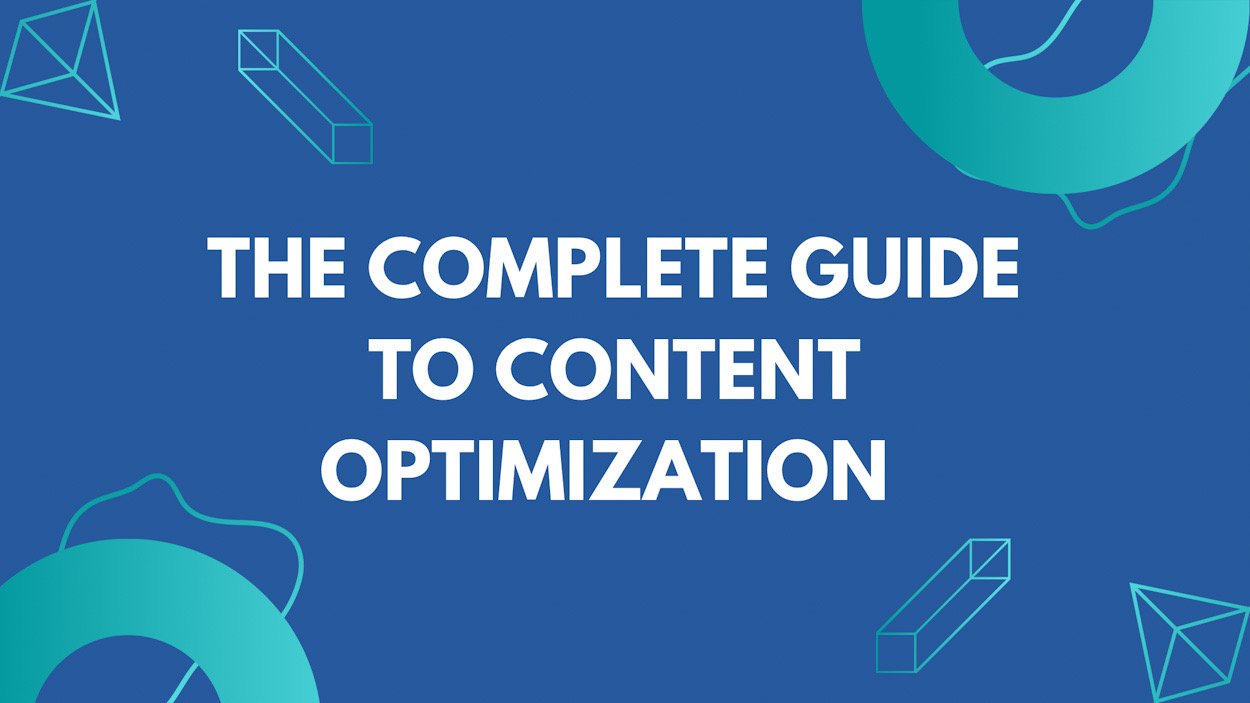Content optimization in SEO helps in your content creation process by ensuring your blog posts are of high quality content and built in the perfect way. Moreover, by following the key elements of on-page SEO best practices, you’ll have great content that performs well on search engines.
As always, the first thing we always say is: you need to have high-quality content that is unique and matches the search intent you are targeting. If you do not have a great content marketing strategy that produces copy and stellar blog posts, no optimization tool or amount of content optimization will help you succeed online.
Remember, optimization of blogs and content can only happen after it’s been written. Much of the optimized content is produced further down the production line. So, if you are sure you have great content to start off with, then you have found the right blog!
SEO content optimization can pay huge dividends to website owners and content marketing efforts. Whereas, properly optimized content is the best way to rank well on Google search, and drive traffic to your website.
What is optimization in SEO, and how to do content optimization in SEO, you ask?
In this guide we will answer just that. We will help you learn how to optimize content for SEO, improve rankings during the process and optimize for better conversion rates.
Let’s jump right in and have a look at what content optimization is.
Table of Contents
What is content optimization in SEO?
Content optimization is the process of improving your content in order to increase ranking and visibility on search engines. To optimize website content it needs to match search intent, while utilizing keywords in titles, meta descriptions, and in the body of the content as well as optimizing for internal links, external links and their anchor text.
In other words, using content writing for SEO best content practices to achieve your desired content goals. There are an array of optimization tactics that can be used, both White Hat and Black Hat, that will increase the likelihood of a search engine ranking your content better in search results.
Optimizing content can happen at anytime during the content creation process. Whereas you can optimize a blog post while writing it, or you can optimize an existing content piece. In reality, a content writer or content creator should look to optimize during both times, by utilizing a content optimization tool, or by using Google search console for existing content.
Now that you have an idea of what search engine optimization is for your content, let’s discuss why it is important.
Why is content optimization essential?
Content optimization is important because it helps your content increase its visibility and ranking on search engines. Content optimization ensure the content is search engine friendly by sending signals to search engine bots about what the content is about so it can rank it accordingly.
Overall, by optimizing content webmasters will be able to improve their content’s performance, conversions and achieve their content marketing goals. If you don’t have good content search engines will not display your content to users in search results pages.
Therefore, if your overall SEO strategy does not include high-quality, original content, you will find it difficult to drive organic traffic to your website. This will result in the website having to to rely on another source like social media, or paid traffic. Which will end up costing you more time, money and resources.
We are all aware that quality content is what matters. However, depending on the overall SEO goals, the type of content and content optimization taking place can differ. For example, if your business goal is to optimize content for SEO you need to do keyword research and search analysis to find a relevant keyword to target and go after. On the other hand, if you are wanting to increase your conversion rate you will need a product-led approach that involves copywriting.
The particular content optimization strategy that you choose will be different than someone else’s and therefore can not be copy and pasted to fit your business. It is important to conduct your own market analysis and SEO audit to figure out exactly what your business needs.
Even though the particular strategies and goals will be different, the SEO methods and tactics to optimize content with will be roughly the same.
In the next section we discuss how to optimize content for SEO with six different steps.
What are the keys to content optimization?
As a content marketer, the main reason to optimize content is more than likely to drive more organic traffic, attract more leads and email subscribers, and convert them into customers. To do this, you will need a strong SEO and content strategy to monitor your progress and ensure your efforts are leading you in the right direction (have a look at our blog covering how to set SEO goals for success!) To monitor your website content optimization efforts, you can use Google Analytics as well as Google Search Console.
Let’s take a look at how to optimize content for SEO with the following SEO optimization tips:
1. Targeting the right keyword
Keyword research plays an essential role to help you identify the keywords you need to target for your business. Optimizing for keywords that have no search is pointless and even if you rank for #1 you won’t get traffic from anywhere.
You can identify keywords with high traffic potential, by using a SEO content optimization tool like Ubersuggest, Semrush, Keywordtool, or Ahrefs.

- Open any one of the tools (we’re using Ubersuggest)
- Enter a broad keyword related to your topic/ service
- And hit search
For example, do a keyword research for “content marketing” and check the “keyword overview” report. The report shows that you’ll get around 15,000 keyword ideas with search volumes, keyword/seo difficulty, paid difficulty and cost per click (CPC).
If you scroll further down, you will see a metric that shows the estimated monthly organic traffic to the current top pages. These numbers will help you give an idea of how much traffic you can get by ranking in pole position.
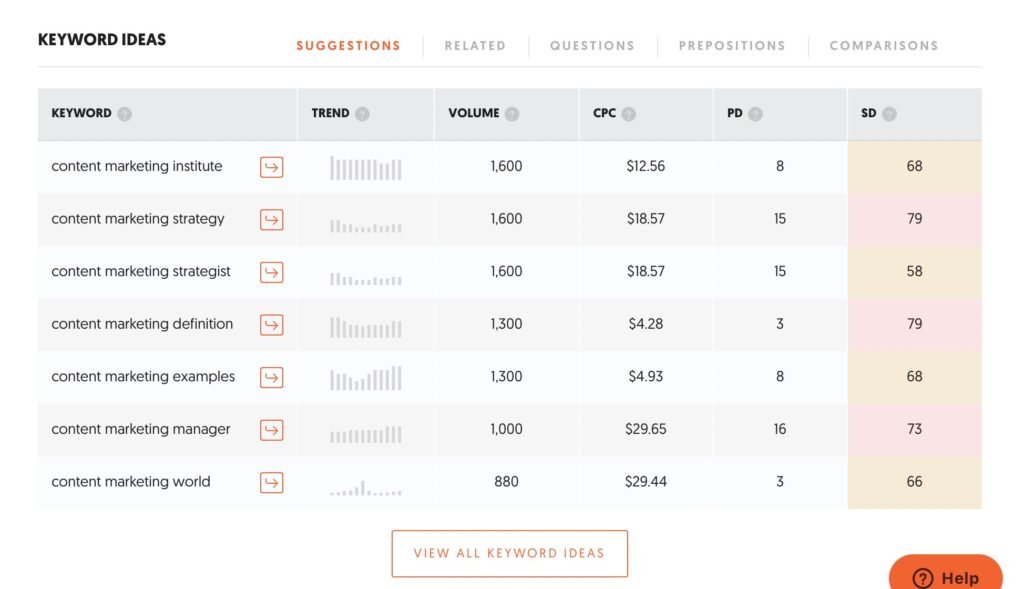
Additionally, if your website is new and has low domain authority, you can target low hanging keywords that have high search volume and low keyword difficulty. In the image below from Ubersuggest, you can see an example of a low-hanging keyword phrase:
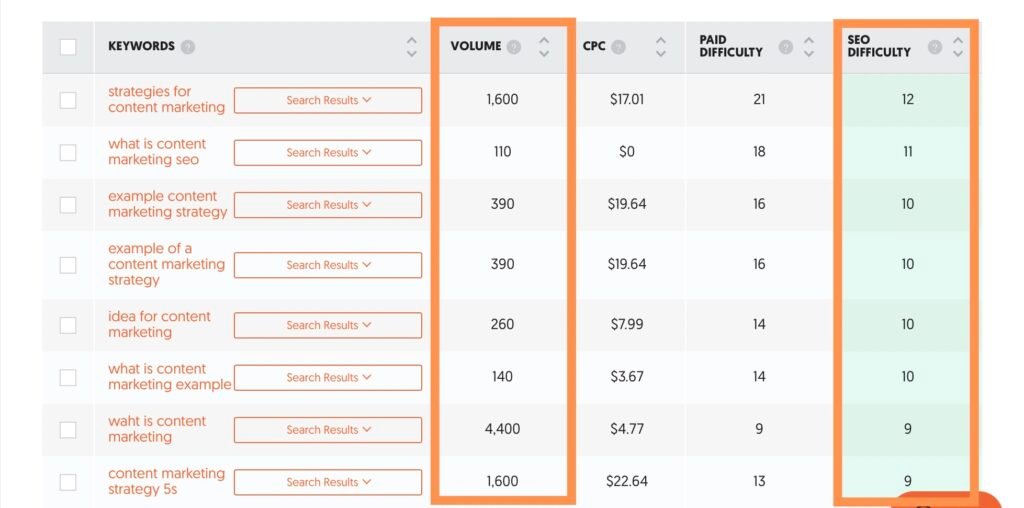
2. Your content aligns with your search intent
Undoubtedly if you don’t align your goals with the searcher’s intent, then you’re already a dead fish in the water. Every SEO effort starts with a search intent and Google prioritizes the search intent. For example, if you fail to answer the searcher’s question, it signifies that your content is low-quality and therefore, a poor match for the query and is not suitable to rank in SERPs.
To understand the search intent you can use the top ranking results as a proxy. You can analyze them according to the three C’s of search intent:
- Content type: What is the type of content in SERPs – is it a blog post, landing page, product page, or category page. If the top ten positions for your keyword shows landing pages then stick to landing pages. Don’t try to do something unique into the SERPs cause numbers don’t lie and it probably won’t work!
- Content format: What type of content format can you see in the search results. For example, how-to, guide or lists. The posts that are competing in the top three positions show what the searcher wants to know. Suppose, if the first page of Google shows lists, then do a listicle for your content. If it shows up with “how-to” then follow that format and vice-versa.
- Content angle: What is the unique selling point of competing content in the search results. For instance, discounts, free shipping, cost-effective strategies etc. It’s crucial to stand out from the crowd but it’s still essential to consider the similarities between all the top ranking pages.
For example, if we look for the keyword “SEO” in the search results, the content type is blog and the content format is a guide:

If you want to make yourself a place in this standing for this query, then you should follow the same style.
3. Answer everything the searchers want to know
Are your posts up to the standard? Does it stack up against the competitors and match search intent better than their content?
It is essential to do a content gap analysis to see how good you’re doing with your content. The idea is to identify opportunities or missing subtopics that searchers want to know about and brainstorm how you can write content that can offer more value than other existing content on the web.
One way you can do this is by conducting an SEO competitor analysis. This means looking into your competitors content, backlink profile, and their keyword research. Additionally, while conducting your analysis you will want to take note, target and optimize to win featured snippets that your competitors may have already won.
A featured snippet is one of the best and quickest ways to increase your visibility and drive traffic to your website. These snippets, or answer targets are short concise pieces of content that answers a search query directly. Winning snippets can add immense benefits to your website and organic traffic, that is why webmasters should know why featured snippet is important.
4. Make sure it’s easy to read
Majority of the readers don’t read pages line to line or from beginning to end. They search for main points and select phrases that are relatable to the solution they are looking for.
To make your content easier for skim readers and more compelling you can:
- Less fluff: Readers lose interest quickly if your page consists of hard to read sentences, jargons, cliches and low-impact adverbs. You can use Grammarly or Hemingway Editor to help you check your grammar, errors, and readability issues.
- Add images to your text: Only a page of text can overwhelm readers. You add more variety to your post by using short paragraphs, bullet points, have bold headings, and include relevant images to make your page more user-friendly.
- Add a table of contents: If your post is long, it’s always a good idea to add a table of contents as it makes navigation easy and informs the reader the topic covered in the posts.
- Prioritize key information: A well optimized post doesn’t only mean following good SEO rules but is also having access to important information. You don’t want your reader to dig through your content looking for information. Always put your best ideas at the top and leave with nice-to-know information at the bottom.
5. Compelling title tags and meta descriptions
Title tags and meta descriptions are the first thing that a searcher will see on the SERPs. Title tags and meta descriptions must summarize what the content is about in one glance.
Few tips to note while writing them are:
- Match the searchers intent: The title tag and meta description must be able to answer the searchers query.
- Short and sweet: Long title tags and meta descriptions will get truncated after a specific length. Usually this is around 70 characters for title tags and 120 characters for meta descriptions, although it varies.
- Don’t forget to include your keyword: Including keywords in your title and description will help the searchers see that your page is a relevant match to their search query.
- Highlight specificity: According to Ahrefs, specifying data points increases credibility and respect. For example, “How to Get More Customers in a Month” or “How to Get 3,478 Customers in a Month on a Budget.” Which are you more likely to click?
Title tags and meta descriptions do a great job at grabbing someone’s attention while they are searching for things. Another important aspect to optimize on your website is its structured data. Using structured data will result in rich snippets being shown for your website in the SERPS. These rich results will provide additional information regarding your page, and increase the page’s click through rate!
6. More backlinks
Without a doubt, backlinks ensure that your site is in Google’s good books, as they’re one of the major ranking factors.
Ahrefs search traffic study shows that higher the backlinks a page has, the more organic traffic it attracts. The image below shows the shift between monthly organic search traffic and the number of backlinks from external websites (referring domains).
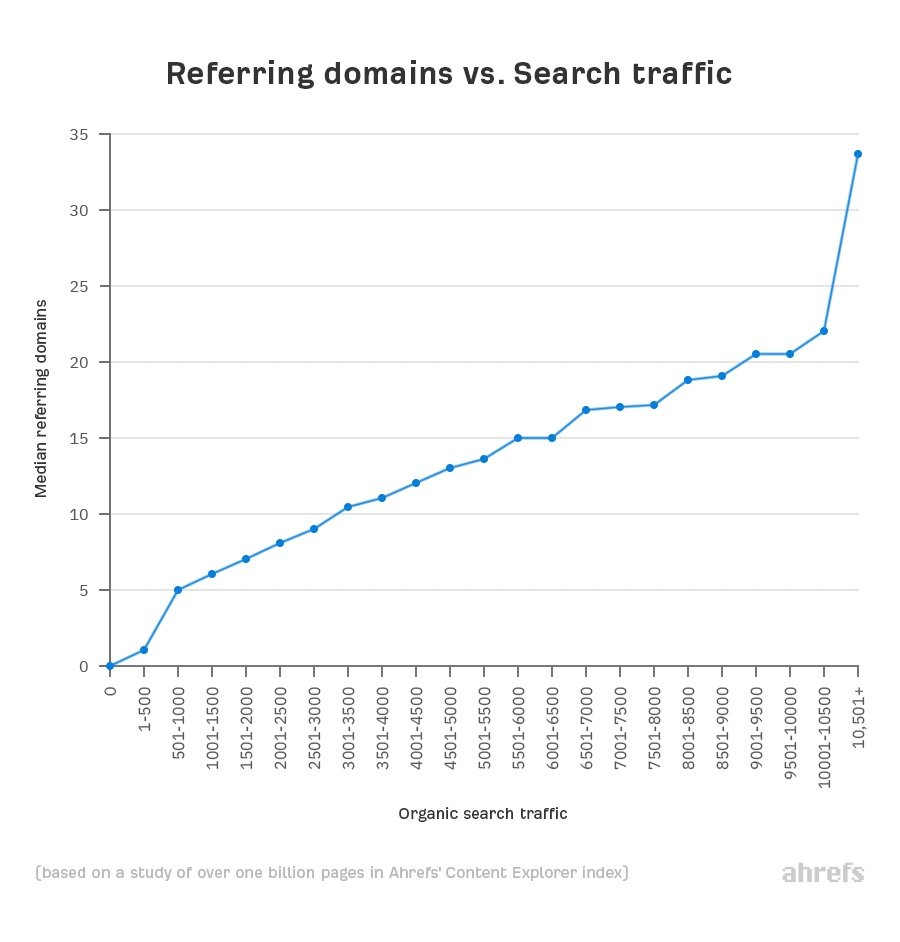
Moral of the story, if you want to rank higher in search results, you will need to build backlinks from authoritative and relevant websites. The best way to do this is with high-quality authoritative content, which people in your industry can trust and link back to.
7. Use a content grader for blog content optimization
A great way to ensure that your content is fully optimized for a target keyword phrase is to use a content grader. A content grader will analyze a blog post and compare it to the content ranking in the top SERP positions. It will then provide a list of additional semantic keywords and phrases that should be included in the post to rank better.
Content grading tools are great SEO content optimization tools as they provide content creators with actionable steps to produce content that can rank. Some of our favorite content optimization tools while grading content include:
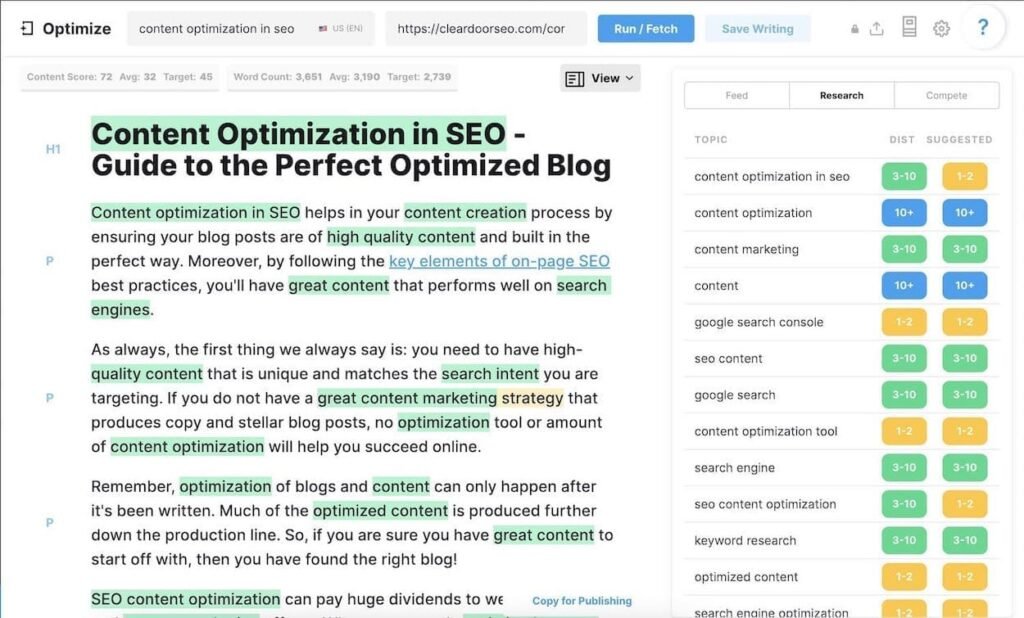
The tools take a lot of the guesswork out of how to optimize content and what keywords to use as well as what is the optimal word length a blog post should be. Additionally, you can also see how the top ranking articles are performing as it provides you with their content score as well as word count.
These are some of the best website content optimization tools around and if you want to take your content to the next level and rank for more terms, we highly recommend checking the tools out (MarketMuse has a free trial you can test)!
8. Check for duplicate content
Duplicate content can severely damage your SEO ranking and traffic flow. It’s important to check for duplicate content regularly and take appropriate action if you find it.
Google dislikes duplicate content so much, they released an article on it, and had this to say:
“Google tries hard to index and show pages with distinct information.”
This means that if a website has duplicate content, Google may end up choosing one option over the other, and only ranking the one that it chose. This is known as an issue with content or keyword cannibalization.
If you find that your website has this issue, one of the best SEO content optimization tips is to identify the source of duplicate content, and change it. By making your content unique, Google will not have to pick between competing articles to rank them. In addition to increasing visibility on search engines, you will also provide more value to your readers as you are providing them with unique and fresh content.
Our favorite free SEO content optimization tools to use to check for duplicate content are:
Both of these tools are free versions that allow you to check the amount of duplicate content throughout your website. Make sure to use these tools to find any duplicate content. Remember that if you find content that is duplicated then you need to remove it as quickly as possible. This will help with content optimization and boost your website’s rankings and help to increase website traffic.
9. Update outdated content
One of the best ways to ensure that your website is seen as an authority on your topic is to make sure that your content is up-to-date and relevant. This means that you need to regularly update the information on your website, whether it’s blog posts, articles, or anything else.
There are a few reasons why updating your content is important:
- It gives your website a fresh look and makes it more appealing to visitors
- It shows that you’re committed to providing quality information and helping people learn more about the topics you cover
- It keeps you current with the latest trends and developments in your field, which will make you more credible
- Google loves fresh and up-to-date content and tends to rank it better
Updating content can be done in various ways. A few different ways to update your content include:
- Change the text throughout the content to add more value
- Update your external links to more relevant resources
- Use an internal link from a new relevant source on your website
- Change the dates in your title tag, header tag, and meta description
- Use up-to-date statistics
- Change the URL structure and permalink if it has the date in it (but be careful!)
In regard to the last point, changing the URL structure of a page can be a big undertaking and can result in some errors if not done correctly. However, if you do decide to change the structure because it includes the date in it, you can see massive changes in rankings.
Take Neil Patel’s case study for example:
How to optimize content for conversions
As we know that SEO can bring you loads of traffic but that traffic is useless if your content doesn’t convert into customers. And the trick to increase conversions is to write product-focused with compelling copywriting skills.
1. Ensure it targets a business potential keyword
Ranking on the first page of Google isn’t the ultimate mark when measuring the success of content marketing. Ranking and being able to generate consistent leads and sales is a content marketing’s success.
However, many businesses only focus on creating mountains of blogs without considering the business potential keyword or topic. They post often about topics that have nothing to do with their product or service. It also ends with a pushy call to action (CTA) that serves no value to readers.
Therefore, it is crucial to target keywords or topics that are relevant to your business.
2. Show how your product or service works
As a business owner, your work is only half done if you fail to inform your prospects on how your product works. Targeting business potential keywords might get you traffic but if you cannot show how your product can be helpful to your target audience then that traffic adds no value. After all, the point of choosing a business potential topic or keyword is to educate your prospects.
However, you need to show how your products work, not just putting it in words.
For instance, notice how we demonstrate different tools and examples to help you optimize your website or content? You are more than likely to hit the close button if we make a bold statement without backing it up with proof.
3. Persuasive call to action
It’s important to include persuasive CTA buttons to encourage readers to take action towards solving their problem. This button could be anything – subscribing an email list, booking a free consultation, or even leaving a query in the comments.
But what makes a CTA powerful?
- Emotion: High-conversion driven CTAs speak louder to the readers pain points and goals and triggers to take an urgent action. Your CTA should make readers that you get them!
- Credibility: Only after you have built trust with your audience, follows sales. You need to build credibility and appeal to skeptical buyers with proof like specific data, endorsements and reviews.
- Timing: Just like it is important to align your content with the searcher intent, effective CTAs align where the prospect is in the buyer’s journey. Be confident and spread your CTAs like confetti!
How to optimize your content for social shares
It is evident that the more people share your content, the more attention it receives. So in this final section, let’s dive into how you can increase your presence on different social networks.
1. Include expert quotes
Including unique quotes from specific subject matter experts will help to boost distribution of your content.
Your odds are higher when readers see a feature source in your post. Because you’re not only producing organic content, but also back up claims. By doing this, experts you feature will share your content and will help you to gradually increase your audience.
2. Make your share buttons visible
Majority of the visitors are skim readers and will probably won’t be able to make it to the end of your post. Additionally, they will most likely ignore the social share buttons at the end of your post.
Therefore, in these instances, you can use sticky share buttons from tools like AddThis and Sumo come in handy. The anchored button stays on the screen while the reader scrolls and is more likely to notice, click and share the post.
Key takeaways: Content optimization in SEO
When done correctly content optimization helps your pages power up, gain a head start and gives you the most out of your content efforts. It plays an integral role in the content development and marketing process. It is important to optimize all aspects of your content to make the optimization process seamless. After all, your content won’t be successful without being fully optimized.
You can try the SEO optimization tips that we listed to rank higher in the SERPs, increase social shares and attract the best audiences for your product and services. However, if you need help from a SEO service provider to increase traffic and rank higher you can contact us. Clear Door SEO is an SEO agency in Portland Oregon who offers SEO services including on-page SEO, off-page SEO and SEO content writing.
